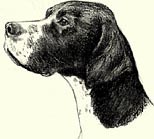History of the Pointer |
THE POINTER HAS BEEN CALLED "the gun dog par Excellence," and was named for the work he does- pointing game for the huntsman. At first called "the pointing dog," his lineage traces to sporting breeds imported into England from various continental countries, among them France, Italy, Germany, and Spain. But it is acknowledged that the chief country of development of the modern Pointer was England. Towards the end of the 17th century a dog known as the double-nosed Spanish Pointer was used by huntsmen to locate game. This breed, it is reported, was both slow and cautious-too slow to keep pace with the advance in firearms-so a cross to the Foxhound produced a dog with the necessary speed. It has also been suggested that various other crosses were employed, namely setter, bloodhound, and greyhound. While some are said to have been disastrous, British breeders persisted until they had developed a dog that had a keen nose, intense concentration, pace, stamina, and nerve, while at the same time being amenable to discipline. The first dog show held was in Newcastle-on-Tyne, Northumberland, in 1859. The purpose of the show was to prove that a working field dog could also be a beautiful animal. While this event was exclusively a competition for pointers and setters, it is historically important because it was the forerunner of the all-breed championship show. A breeder from the north of England, William Arkwright, is credited with improving and stabilizing the breed. Old prints dating to Arkwright's time show little change from the good dogs of his day to the modern Pointer. The head is carried high, the tail extended straight behind him as his upturned nose with wide open nostrils searches the air for scents of game. When he locates it, the dog freezes "on point." Many are the tales told of dogs so well trained they held this statue-like pose for several hours. White with liver, black, orange, or lemon markings are the usual coat colours, although self-coloured is also acceptable and at one time there was a strain of solid blacks. The Westminster Kennel Club show catalogue (1877) lists more than 100 Pointers in competition. Classes were divided "under and over fifty pounds." Winner of the Open Male class was listed for sale at $100. In 1889 there were fifty-four Pointers registered with The Canadian Kennel Club. |

